Search the Special Collections and Archives Portal
Search Results
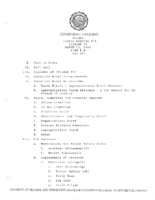
Meeting minutes for Consolidated Student Senate University of Nevada, Las Vegas, March 13, 1984
Date
Archival Collection
Description
Text
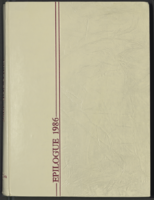
Epilogue: UNLV Yearbook, 1986
Date
Description
Yearbook main highlights: schools and departments; detailed lists with names and headshots of faculty, administration and students; variety of photos from activities, festivals, campus life, and buildings; campus organizations such as sororities, fraternities and councils; beauty contest winners; college sports and featured athletes; and printed advertisements of local businesses; Institution name: University of Nevada, Las Vegas
Mixed Content
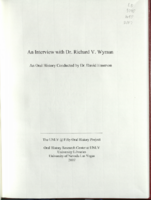
Transcript of interview with Dr. Richard V. Wyman by Dr. David Emerson, February 27, 2006
Date
Archival Collection
Description
Text
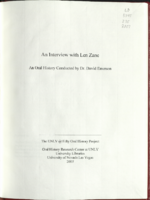
Transcript of interview with Len Zane by Dr. David Emerson, May 10, 2007
Date
Archival Collection
Description
Text
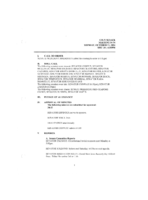
Meeting minutes for Consolidated Student Senate, University of Nevada, Las Vegas, October 11, 2004
Date
Archival Collection
Description
Text

Krystal Ramirez oral history interview: transcript
Date
Archival Collection
Description
Oral history interview with Krystal Ramirez conducted by Monserrath Hernández and Barbara Tabach on October 30, 2019 for the Latinx Voices of Southern Nevada Oral History Project. Krystal talks about her personal history growing up in Texas and spending summers with her family in Mexico. She shares her thoughts about how Las Vegas has changed and how she has contributed to the city's art scene as a staff photographer for Vegas Seven (a local magazine), the New York Times, and the Marjorie Barrick Museum. Subjects discussed include: Texas; Chihuahua, Mexico; Latinx Identity; Vegas Seven; Beat Coffee House; Downtown Las Vegas.
Text
Darnell, Marshall, 1937-2014
Marshall C. Darnell was born in Harrodsburg, Kentucky. He receieved his bachelor's degree in social science and English from Eastern Kentucky State College. He moved to Las Vegas in 1960 and began working as a subsititute teacher at Rancho High School. He then began teaching at Bridger Junior High School, and took a leave of absence in 1963 to earn his Master's degree. In 1964, he married Patsy Lucile Pace. After earning his degree, he held several positions in the Clark County School District (CCSD).
Person
Kelley, Fiona
Dr. Fiona Kelley was born and raised in Connecticut. Her parents were both teachers (though her mother quit teaching to raise their two daughters), and the family would take European vacations every summer, exploring castles and enjoying picnic lunches.
Person
Ann McGinley oral history interview
Identifier
Abstract
Oral history interview with Ann McGinley conducted by Claytee White on August 01, 2006 for the UNLV @ 50 Oral History Project. McGinley discusses her careers working as a lawyer and teaching at several law schools before coming to teach at the Boyd Law School at the University of Nevada, Las Vegas in 1999.
Archival Collection

